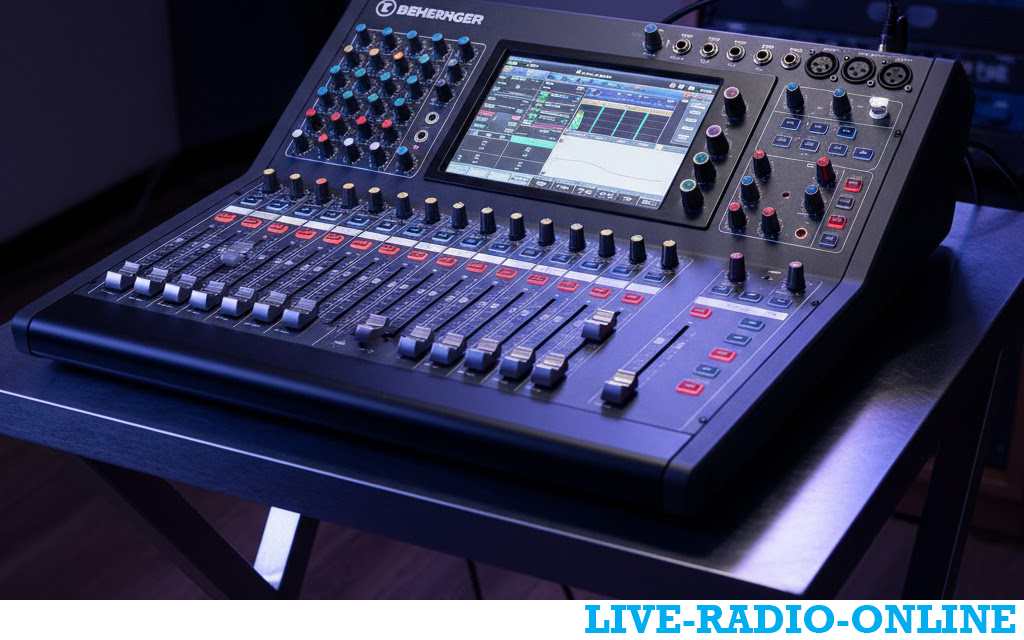
The Behringer X32 Compact (and its very similar sibling, the X32 Producer) is indeed a phenomenal choice for radio production and broadcasting.
While large radio stations might use dedicated broadcast consoles, the X32 series has become the workhorse for countless internet radio stations, podcasts, college radio, production studios, and even professional on-air rooms due to its incredible flexibility, sound quality, and feature set for the price.
Here’s a detailed breakdown of why it's so perfectly suited for radio:
1. Channel Count and Flexibility
-
More than Enough Inputs: The X32 Compact has 16 local mic preamps, while the Producer has 12. This is more than enough for a typical radio setup: multiple hosts, guests, phone hybrids, codec lines, multiple computers for playout/DAW, and a dedicated mic for news/sports.
-
Bus/ Aux Sends for Mix-Minus: This is CRITICAL for radio. To send audio to a caller or a remote guest without them hearing their own voice (which causes echo), you create a "mix-minus." The X32's 6 aux buses (or the 8 on the Compact) are perfect for creating these clean feeds. You can have separate mixes for a phone line, a Skype/Teams computer, and a remote reporter.
-
DCAs for Effortless Control: You can group channels (e.g., "All Mics," "All Playback Computers," "All Remote Sources") onto a single fader called a DCA. This allows the host or engineer to easily push the level of all mics up or down without changing the mix between them. It makes live show control incredibly intuitive.
2. Built-in Digital Snake and Expandability
-
S16 Stagebox: If you need to run a broadcast from an auditorium or a remote location, you can connect an S16 stagebox via a single Ethernet cable. This gives you 16 more mic preamps stage-side, keeping the main console clean and compact in the control room. This is a huge advantage for remote broadcasts.
3. Superb Onboard Effects
-
Channel EQ and Dynamics: Every channel has a fully parametric 4-band EQ and a compressor/gate. This is essential for making voices sound clear, consistent, and professional, while also controlling background noise.
-
Reverbs and Delays: The console includes high-quality effects that can be used for production elements, voice sweetening, or creating specific imaging for your station.
-
RTA (Real-Time Analyzer): The built-in RTA on the scribble strips helps you visually identify and notch out problematic frequencies (like room resonances or phone line noise).
4. Integrated Digital Recording and Playback
-
USB Audio Interface: The X32 can connect to a computer via USB and act as a 32x32 audio interface. This means you can:
-
Record your show multi-track directly into a DAW like Reaper, Pro Tools, or Audacity for post-production.
-
Play audio from your computer (e.g., jingles, songs, pre-recorded segments) into the console on dedicated channels.
-
-
Ultranet Port: You can connect a Behringer P16 personal monitor mixer or, more relevantly, a Behringer SD8 to create a simple, affordable "announcer's booth" with a headphone mix and a start/stop trigger for the playout software.
5. Physical Form Factor
-
X32 Compact: The angled surface is perfect for a studio desk. The presenter can see and reach all the faders and controls easily. It's the ideal balance between size and capability.
-
X32 Producer: The smaller, flat form factor can be great for space-constrained environments, though the angled surface of the Compact is often preferred for ergonomics.
6. Scene Memory
This is a game-changer for radio. You can save the entire console's state into a Scene.
-
Show Presets: Create a scene for your morning show, your news hour, your evening music program, and your production session. Recall a scene, and all the faders, EQs, routing, and effects instantly change.
-
Safe Guards: You can "safe" certain parameters (like your main output level or critical routing) so they don't change when you recall a scene, preventing on-air disasters.
Potential Setup for a Radio Station:
-
Channels 1-4: Host/Co-host Mics (with gates and compression)
-
Channel 5: Phone Hybrid / Telco
-
Channel 6-7: Playout Computer 1 (Stereo Music)
-
Channel 8-9: Playout Computer 2 (Stereo Jingles/Beds)
-
Channel 10-11: DAW/Production Computer
-
Aux 1: Mix-Minus to Phone Hybrid
-
Aux 2: Mix-Minus to Skype/Teams Computer
-
DCA 1: All Mics
-
DCA 2: All Playback Audio
The One Caveat:
The learning curve can be steep for someone used to a simple analog mixer. Taking the time to learn the routing and setup is essential to unlock its full potential. However, once configured, it's arguably easier to operate consistently and safely than a simpler mixer.
Conclusion:
The Behringer X32 Compact (or Producer) isn't just "good enough" for radio; it's a professional-grade, feature-rich console that offers broadcasters capabilities that were once only available on systems costing many times more. Its power, flexibility, and reliability make it a phenomenal choice for modern radio production and broadcasting.


